HNN318: Clinical Decision Making & Geriatric Hygiene Management
VerifiedAdded on 2023/04/24
|10
|3061
|169
Essay
AI Summary
This essay explores clinical decision-making by registered nurses in planning, coordinating, and providing personal hygiene care to older adults during acute hospital admissions. It highlights the importance of evidence-based decisions to optimize health outcomes, emphasizing the unique gerontological needs of older patients. The discussion includes the use of tools like the Oral Health Assessment Tool (OHAT) and strategies for skin care, alongside addressing risk factors such as malnutrition and incontinence. A detailed examination of urinary incontinence, its causes (stress, urge, overflow, functional, and mixed), assessment methods, and impacts on health, wellbeing, and personal hygiene is provided, noting the psychological and physical consequences, including social isolation and increased risk of falls. The essay concludes by stressing the need for a multidisciplinary approach and comprehensive interventions to enhance the quality of life for older adults in acute care settings.
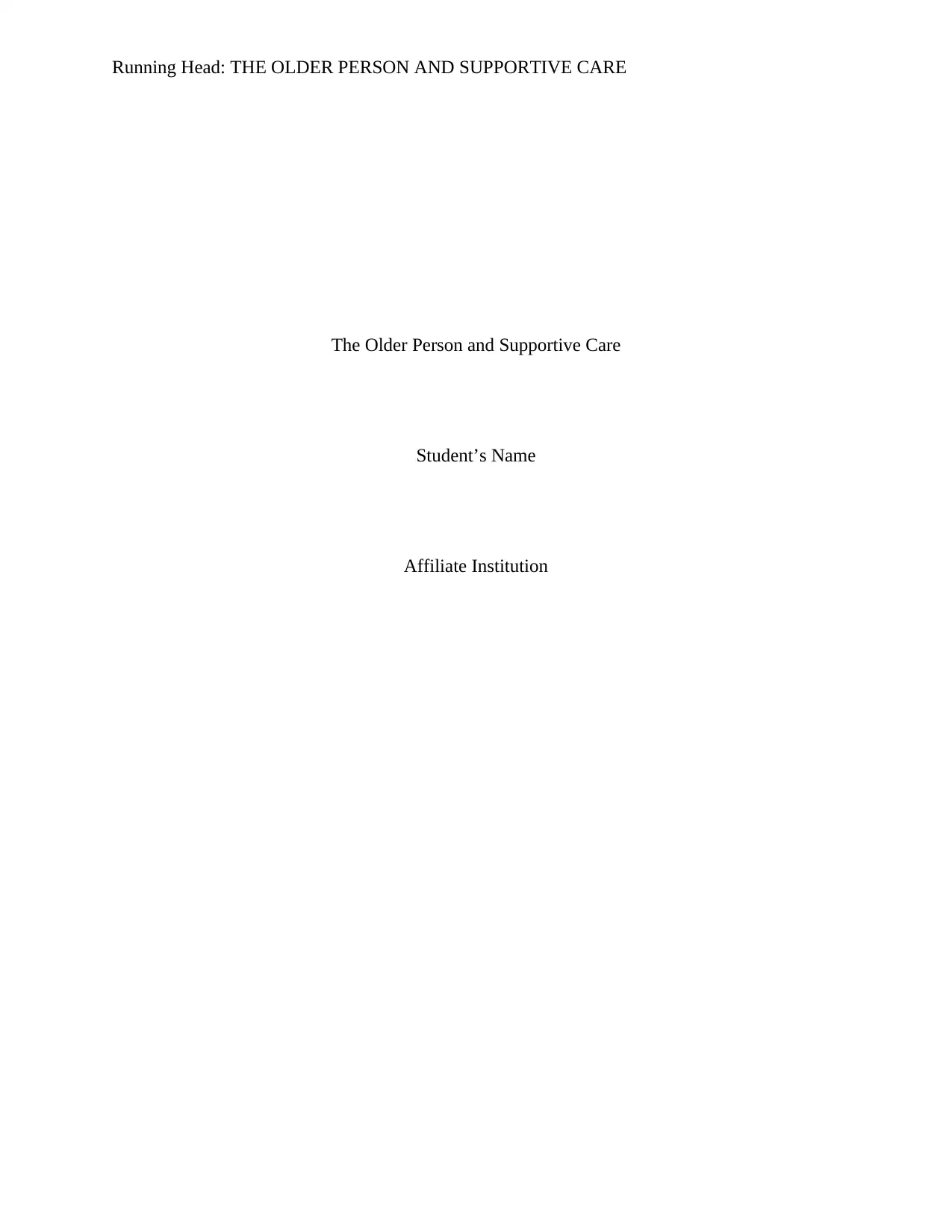
Running Head: THE OLDER PERSON AND SUPPORTIVE CARE
The Older Person and Supportive Care
Student’s Name
Affiliate Institution
The Older Person and Supportive Care
Student’s Name
Affiliate Institution
Paraphrase This Document
Need a fresh take? Get an instant paraphrase of this document with our AI Paraphraser
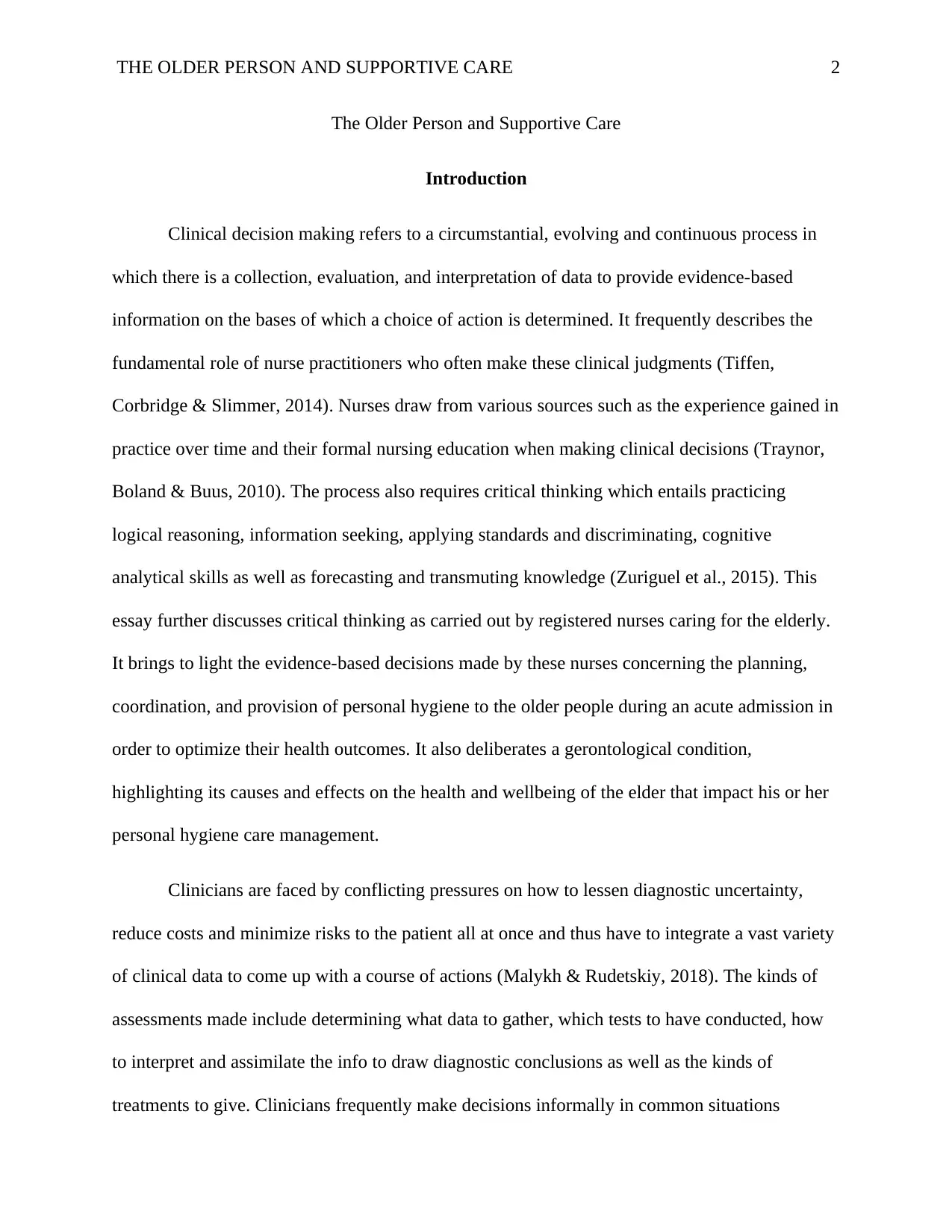
THE OLDER PERSON AND SUPPORTIVE CARE 2
The Older Person and Supportive Care
Introduction
Clinical decision making refers to a circumstantial, evolving and continuous process in
which there is a collection, evaluation, and interpretation of data to provide evidence-based
information on the bases of which a choice of action is determined. It frequently describes the
fundamental role of nurse practitioners who often make these clinical judgments (Tiffen,
Corbridge & Slimmer, 2014). Nurses draw from various sources such as the experience gained in
practice over time and their formal nursing education when making clinical decisions (Traynor,
Boland & Buus, 2010). The process also requires critical thinking which entails practicing
logical reasoning, information seeking, applying standards and discriminating, cognitive
analytical skills as well as forecasting and transmuting knowledge (Zuriguel et al., 2015). This
essay further discusses critical thinking as carried out by registered nurses caring for the elderly.
It brings to light the evidence-based decisions made by these nurses concerning the planning,
coordination, and provision of personal hygiene to the older people during an acute admission in
order to optimize their health outcomes. It also deliberates a gerontological condition,
highlighting its causes and effects on the health and wellbeing of the elder that impact his or her
personal hygiene care management.
Clinicians are faced by conflicting pressures on how to lessen diagnostic uncertainty,
reduce costs and minimize risks to the patient all at once and thus have to integrate a vast variety
of clinical data to come up with a course of actions (Malykh & Rudetskiy, 2018). The kinds of
assessments made include determining what data to gather, which tests to have conducted, how
to interpret and assimilate the info to draw diagnostic conclusions as well as the kinds of
treatments to give. Clinicians frequently make decisions informally in common situations
The Older Person and Supportive Care
Introduction
Clinical decision making refers to a circumstantial, evolving and continuous process in
which there is a collection, evaluation, and interpretation of data to provide evidence-based
information on the bases of which a choice of action is determined. It frequently describes the
fundamental role of nurse practitioners who often make these clinical judgments (Tiffen,
Corbridge & Slimmer, 2014). Nurses draw from various sources such as the experience gained in
practice over time and their formal nursing education when making clinical decisions (Traynor,
Boland & Buus, 2010). The process also requires critical thinking which entails practicing
logical reasoning, information seeking, applying standards and discriminating, cognitive
analytical skills as well as forecasting and transmuting knowledge (Zuriguel et al., 2015). This
essay further discusses critical thinking as carried out by registered nurses caring for the elderly.
It brings to light the evidence-based decisions made by these nurses concerning the planning,
coordination, and provision of personal hygiene to the older people during an acute admission in
order to optimize their health outcomes. It also deliberates a gerontological condition,
highlighting its causes and effects on the health and wellbeing of the elder that impact his or her
personal hygiene care management.
Clinicians are faced by conflicting pressures on how to lessen diagnostic uncertainty,
reduce costs and minimize risks to the patient all at once and thus have to integrate a vast variety
of clinical data to come up with a course of actions (Malykh & Rudetskiy, 2018). The kinds of
assessments made include determining what data to gather, which tests to have conducted, how
to interpret and assimilate the info to draw diagnostic conclusions as well as the kinds of
treatments to give. Clinicians frequently make decisions informally in common situations
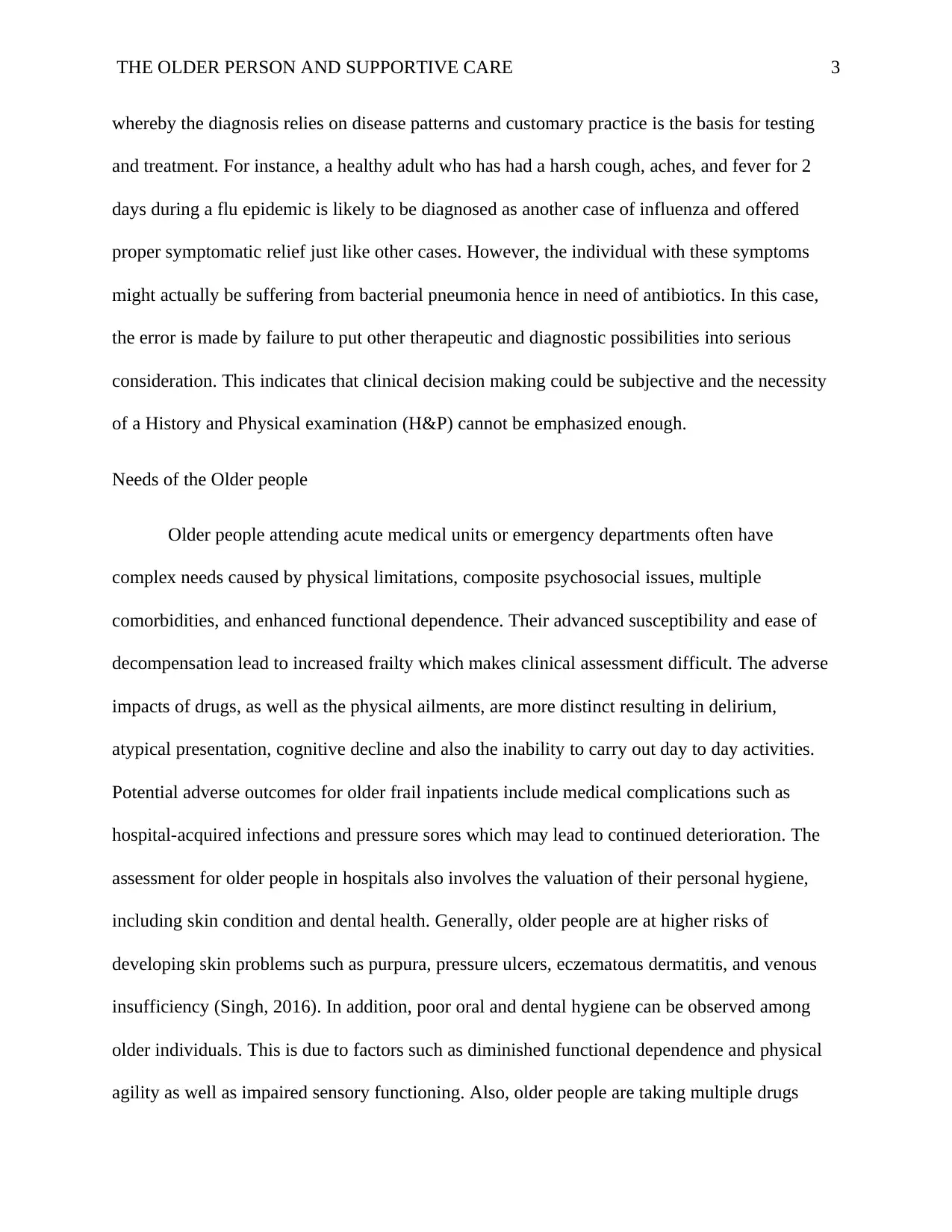
THE OLDER PERSON AND SUPPORTIVE CARE 3
whereby the diagnosis relies on disease patterns and customary practice is the basis for testing
and treatment. For instance, a healthy adult who has had a harsh cough, aches, and fever for 2
days during a flu epidemic is likely to be diagnosed as another case of influenza and offered
proper symptomatic relief just like other cases. However, the individual with these symptoms
might actually be suffering from bacterial pneumonia hence in need of antibiotics. In this case,
the error is made by failure to put other therapeutic and diagnostic possibilities into serious
consideration. This indicates that clinical decision making could be subjective and the necessity
of a History and Physical examination (H&P) cannot be emphasized enough.
Needs of the Older people
Older people attending acute medical units or emergency departments often have
complex needs caused by physical limitations, composite psychosocial issues, multiple
comorbidities, and enhanced functional dependence. Their advanced susceptibility and ease of
decompensation lead to increased frailty which makes clinical assessment difficult. The adverse
impacts of drugs, as well as the physical ailments, are more distinct resulting in delirium,
atypical presentation, cognitive decline and also the inability to carry out day to day activities.
Potential adverse outcomes for older frail inpatients include medical complications such as
hospital-acquired infections and pressure sores which may lead to continued deterioration. The
assessment for older people in hospitals also involves the valuation of their personal hygiene,
including skin condition and dental health. Generally, older people are at higher risks of
developing skin problems such as purpura, pressure ulcers, eczematous dermatitis, and venous
insufficiency (Singh, 2016). In addition, poor oral and dental hygiene can be observed among
older individuals. This is due to factors such as diminished functional dependence and physical
agility as well as impaired sensory functioning. Also, older people are taking multiple drugs
whereby the diagnosis relies on disease patterns and customary practice is the basis for testing
and treatment. For instance, a healthy adult who has had a harsh cough, aches, and fever for 2
days during a flu epidemic is likely to be diagnosed as another case of influenza and offered
proper symptomatic relief just like other cases. However, the individual with these symptoms
might actually be suffering from bacterial pneumonia hence in need of antibiotics. In this case,
the error is made by failure to put other therapeutic and diagnostic possibilities into serious
consideration. This indicates that clinical decision making could be subjective and the necessity
of a History and Physical examination (H&P) cannot be emphasized enough.
Needs of the Older people
Older people attending acute medical units or emergency departments often have
complex needs caused by physical limitations, composite psychosocial issues, multiple
comorbidities, and enhanced functional dependence. Their advanced susceptibility and ease of
decompensation lead to increased frailty which makes clinical assessment difficult. The adverse
impacts of drugs, as well as the physical ailments, are more distinct resulting in delirium,
atypical presentation, cognitive decline and also the inability to carry out day to day activities.
Potential adverse outcomes for older frail inpatients include medical complications such as
hospital-acquired infections and pressure sores which may lead to continued deterioration. The
assessment for older people in hospitals also involves the valuation of their personal hygiene,
including skin condition and dental health. Generally, older people are at higher risks of
developing skin problems such as purpura, pressure ulcers, eczematous dermatitis, and venous
insufficiency (Singh, 2016). In addition, poor oral and dental hygiene can be observed among
older individuals. This is due to factors such as diminished functional dependence and physical
agility as well as impaired sensory functioning. Also, older people are taking multiple drugs
⊘ This is a preview!⊘
Do you want full access?
Subscribe today to unlock all pages.

Trusted by 1+ million students worldwide

THE OLDER PERSON AND SUPPORTIVE CARE 4
concurrently which include antidepressants, diuretics, antipsychotics, and anticholinergics whose
common side effects are a reduced flow of saliva and chewing efficiency resulting in dental
issues. Likewise, poor oral hygiene can be caused by lack of teeth, uncontrolled diabetes,
dysfunction of salivary glands, improperly fitted dentures and reduced mobility.
Decisions on Personal Hygiene of the older people
Planning for the care of older people entails a multidisciplinary approach in which the
elders are also involved. For timely assessment of dental and oral hygiene, nurses both in
hospital settings and care homes can incorporate the use of Oral Health Assessment Tool
(OHAT) screening. They should also educate their patients on the importance of basic decent
oral hygiene and encourage them to reduce their resistivity and reluctance. They should also
engage the help of caregivers with oral hygiene stratagems. Nurses should also embolden the
older people to have a regular checkup for early identification of oral problems. In the case of
skin care, a suitable skin care plan is required, accompanied by a prompt assessment to prevent
or minimize skin issues. Risk factors that could lead to skin problems for older people include
malnutrition, urinary or bowel incontinence, loss of protective fat, cognitive impairment, reduced
physical activity and sarcopenia (Singh, 2016). The nurses should, therefore, encourage and help
the client to exercise regularly, eat a balanced diet, avoid excessive friction or heat, practice
mobilization, and personal hygiene in order to prevent skin breakdown. Promoting continence is
also another way in which some skin issues could be avoided.
concurrently which include antidepressants, diuretics, antipsychotics, and anticholinergics whose
common side effects are a reduced flow of saliva and chewing efficiency resulting in dental
issues. Likewise, poor oral hygiene can be caused by lack of teeth, uncontrolled diabetes,
dysfunction of salivary glands, improperly fitted dentures and reduced mobility.
Decisions on Personal Hygiene of the older people
Planning for the care of older people entails a multidisciplinary approach in which the
elders are also involved. For timely assessment of dental and oral hygiene, nurses both in
hospital settings and care homes can incorporate the use of Oral Health Assessment Tool
(OHAT) screening. They should also educate their patients on the importance of basic decent
oral hygiene and encourage them to reduce their resistivity and reluctance. They should also
engage the help of caregivers with oral hygiene stratagems. Nurses should also embolden the
older people to have a regular checkup for early identification of oral problems. In the case of
skin care, a suitable skin care plan is required, accompanied by a prompt assessment to prevent
or minimize skin issues. Risk factors that could lead to skin problems for older people include
malnutrition, urinary or bowel incontinence, loss of protective fat, cognitive impairment, reduced
physical activity and sarcopenia (Singh, 2016). The nurses should, therefore, encourage and help
the client to exercise regularly, eat a balanced diet, avoid excessive friction or heat, practice
mobilization, and personal hygiene in order to prevent skin breakdown. Promoting continence is
also another way in which some skin issues could be avoided.
Paraphrase This Document
Need a fresh take? Get an instant paraphrase of this document with our AI Paraphraser
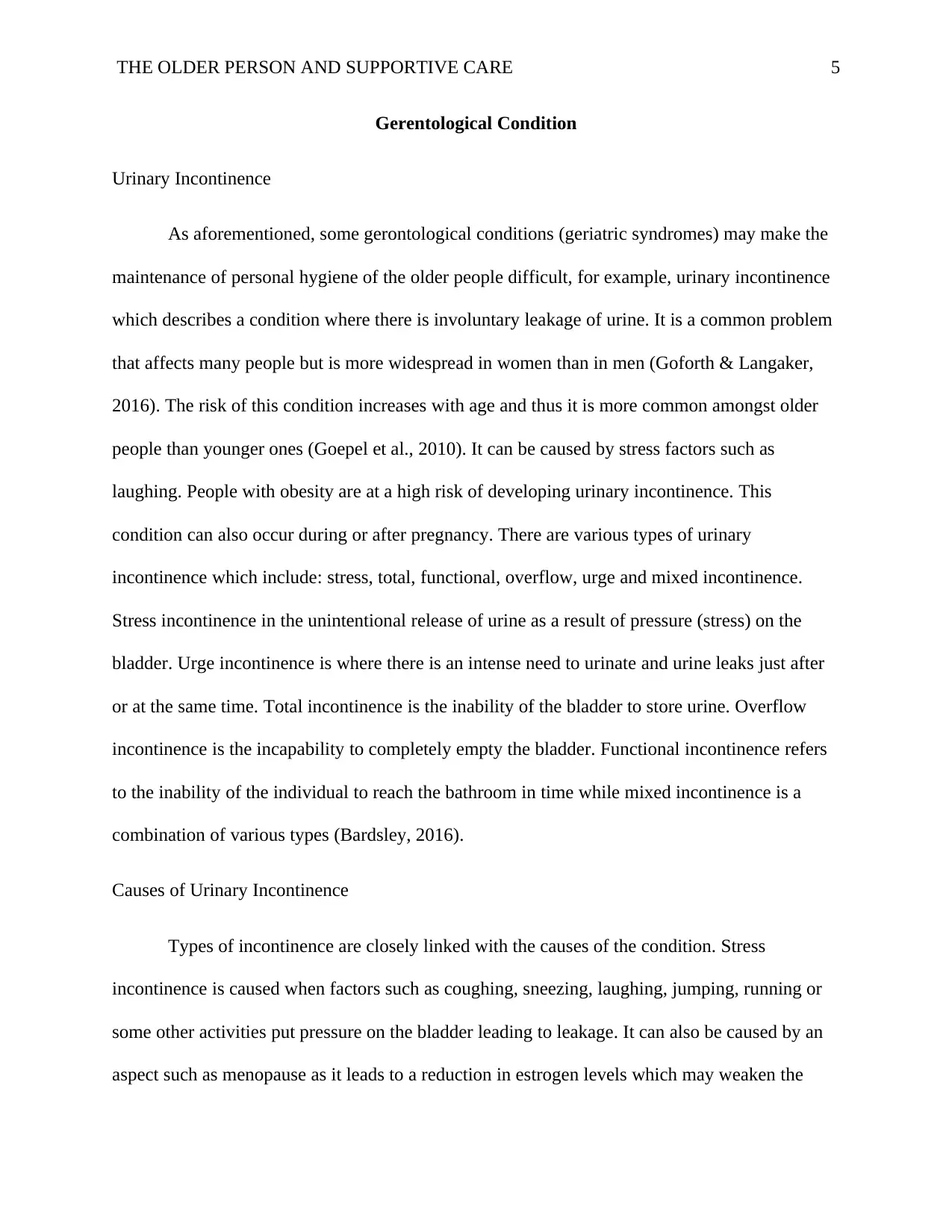
THE OLDER PERSON AND SUPPORTIVE CARE 5
Gerentological Condition
Urinary Incontinence
As aforementioned, some gerontological conditions (geriatric syndromes) may make the
maintenance of personal hygiene of the older people difficult, for example, urinary incontinence
which describes a condition where there is involuntary leakage of urine. It is a common problem
that affects many people but is more widespread in women than in men (Goforth & Langaker,
2016). The risk of this condition increases with age and thus it is more common amongst older
people than younger ones (Goepel et al., 2010). It can be caused by stress factors such as
laughing. People with obesity are at a high risk of developing urinary incontinence. This
condition can also occur during or after pregnancy. There are various types of urinary
incontinence which include: stress, total, functional, overflow, urge and mixed incontinence.
Stress incontinence in the unintentional release of urine as a result of pressure (stress) on the
bladder. Urge incontinence is where there is an intense need to urinate and urine leaks just after
or at the same time. Total incontinence is the inability of the bladder to store urine. Overflow
incontinence is the incapability to completely empty the bladder. Functional incontinence refers
to the inability of the individual to reach the bathroom in time while mixed incontinence is a
combination of various types (Bardsley, 2016).
Causes of Urinary Incontinence
Types of incontinence are closely linked with the causes of the condition. Stress
incontinence is caused when factors such as coughing, sneezing, laughing, jumping, running or
some other activities put pressure on the bladder leading to leakage. It can also be caused by an
aspect such as menopause as it leads to a reduction in estrogen levels which may weaken the
Gerentological Condition
Urinary Incontinence
As aforementioned, some gerontological conditions (geriatric syndromes) may make the
maintenance of personal hygiene of the older people difficult, for example, urinary incontinence
which describes a condition where there is involuntary leakage of urine. It is a common problem
that affects many people but is more widespread in women than in men (Goforth & Langaker,
2016). The risk of this condition increases with age and thus it is more common amongst older
people than younger ones (Goepel et al., 2010). It can be caused by stress factors such as
laughing. People with obesity are at a high risk of developing urinary incontinence. This
condition can also occur during or after pregnancy. There are various types of urinary
incontinence which include: stress, total, functional, overflow, urge and mixed incontinence.
Stress incontinence in the unintentional release of urine as a result of pressure (stress) on the
bladder. Urge incontinence is where there is an intense need to urinate and urine leaks just after
or at the same time. Total incontinence is the inability of the bladder to store urine. Overflow
incontinence is the incapability to completely empty the bladder. Functional incontinence refers
to the inability of the individual to reach the bathroom in time while mixed incontinence is a
combination of various types (Bardsley, 2016).
Causes of Urinary Incontinence
Types of incontinence are closely linked with the causes of the condition. Stress
incontinence is caused when factors such as coughing, sneezing, laughing, jumping, running or
some other activities put pressure on the bladder leading to leakage. It can also be caused by an
aspect such as menopause as it leads to a reduction in estrogen levels which may weaken the
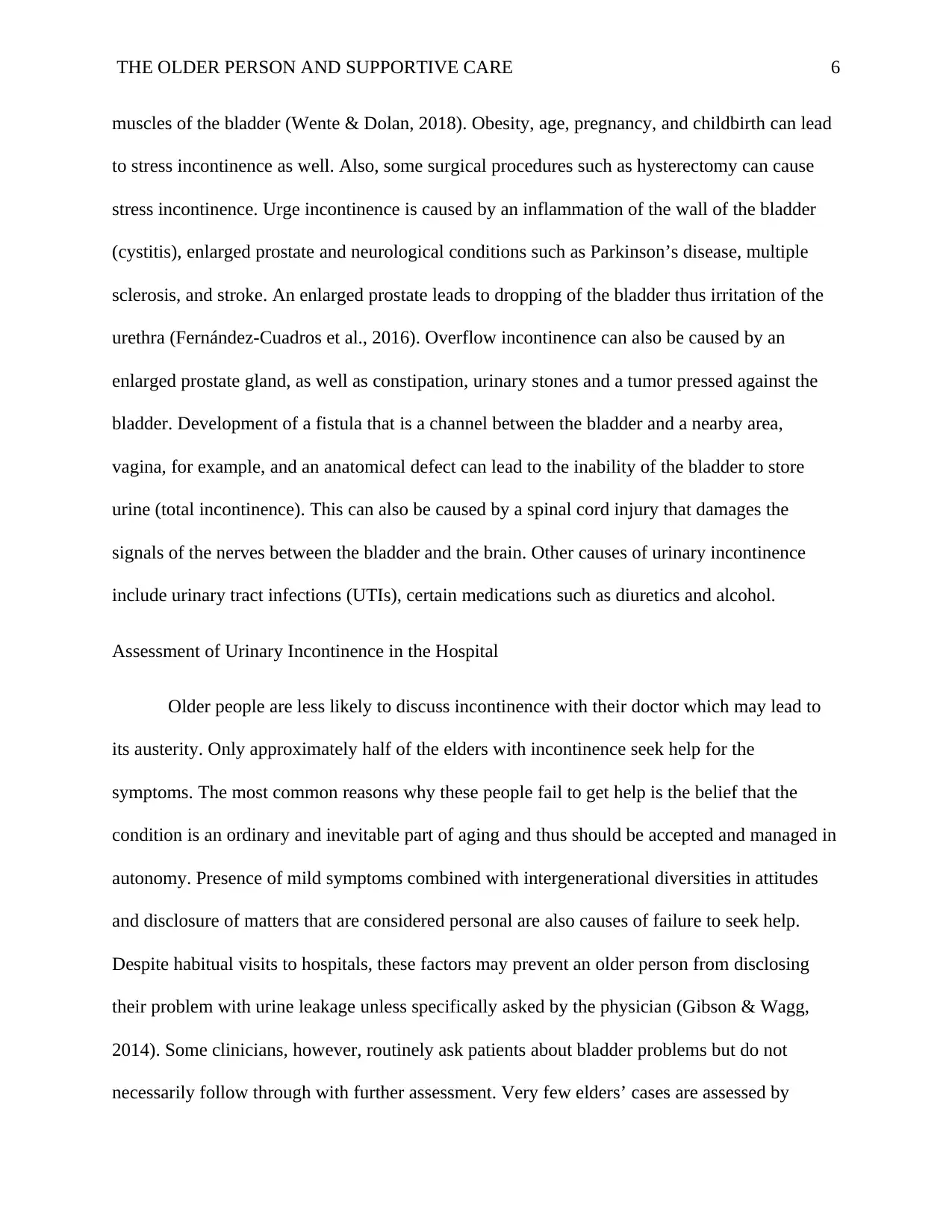
THE OLDER PERSON AND SUPPORTIVE CARE 6
muscles of the bladder (Wente & Dolan, 2018). Obesity, age, pregnancy, and childbirth can lead
to stress incontinence as well. Also, some surgical procedures such as hysterectomy can cause
stress incontinence. Urge incontinence is caused by an inflammation of the wall of the bladder
(cystitis), enlarged prostate and neurological conditions such as Parkinson’s disease, multiple
sclerosis, and stroke. An enlarged prostate leads to dropping of the bladder thus irritation of the
urethra (Fernández-Cuadros et al., 2016). Overflow incontinence can also be caused by an
enlarged prostate gland, as well as constipation, urinary stones and a tumor pressed against the
bladder. Development of a fistula that is a channel between the bladder and a nearby area,
vagina, for example, and an anatomical defect can lead to the inability of the bladder to store
urine (total incontinence). This can also be caused by a spinal cord injury that damages the
signals of the nerves between the bladder and the brain. Other causes of urinary incontinence
include urinary tract infections (UTIs), certain medications such as diuretics and alcohol.
Assessment of Urinary Incontinence in the Hospital
Older people are less likely to discuss incontinence with their doctor which may lead to
its austerity. Only approximately half of the elders with incontinence seek help for the
symptoms. The most common reasons why these people fail to get help is the belief that the
condition is an ordinary and inevitable part of aging and thus should be accepted and managed in
autonomy. Presence of mild symptoms combined with intergenerational diversities in attitudes
and disclosure of matters that are considered personal are also causes of failure to seek help.
Despite habitual visits to hospitals, these factors may prevent an older person from disclosing
their problem with urine leakage unless specifically asked by the physician (Gibson & Wagg,
2014). Some clinicians, however, routinely ask patients about bladder problems but do not
necessarily follow through with further assessment. Very few elders’ cases are assessed by
muscles of the bladder (Wente & Dolan, 2018). Obesity, age, pregnancy, and childbirth can lead
to stress incontinence as well. Also, some surgical procedures such as hysterectomy can cause
stress incontinence. Urge incontinence is caused by an inflammation of the wall of the bladder
(cystitis), enlarged prostate and neurological conditions such as Parkinson’s disease, multiple
sclerosis, and stroke. An enlarged prostate leads to dropping of the bladder thus irritation of the
urethra (Fernández-Cuadros et al., 2016). Overflow incontinence can also be caused by an
enlarged prostate gland, as well as constipation, urinary stones and a tumor pressed against the
bladder. Development of a fistula that is a channel between the bladder and a nearby area,
vagina, for example, and an anatomical defect can lead to the inability of the bladder to store
urine (total incontinence). This can also be caused by a spinal cord injury that damages the
signals of the nerves between the bladder and the brain. Other causes of urinary incontinence
include urinary tract infections (UTIs), certain medications such as diuretics and alcohol.
Assessment of Urinary Incontinence in the Hospital
Older people are less likely to discuss incontinence with their doctor which may lead to
its austerity. Only approximately half of the elders with incontinence seek help for the
symptoms. The most common reasons why these people fail to get help is the belief that the
condition is an ordinary and inevitable part of aging and thus should be accepted and managed in
autonomy. Presence of mild symptoms combined with intergenerational diversities in attitudes
and disclosure of matters that are considered personal are also causes of failure to seek help.
Despite habitual visits to hospitals, these factors may prevent an older person from disclosing
their problem with urine leakage unless specifically asked by the physician (Gibson & Wagg,
2014). Some clinicians, however, routinely ask patients about bladder problems but do not
necessarily follow through with further assessment. Very few elders’ cases are assessed by
⊘ This is a preview!⊘
Do you want full access?
Subscribe today to unlock all pages.

Trusted by 1+ million students worldwide
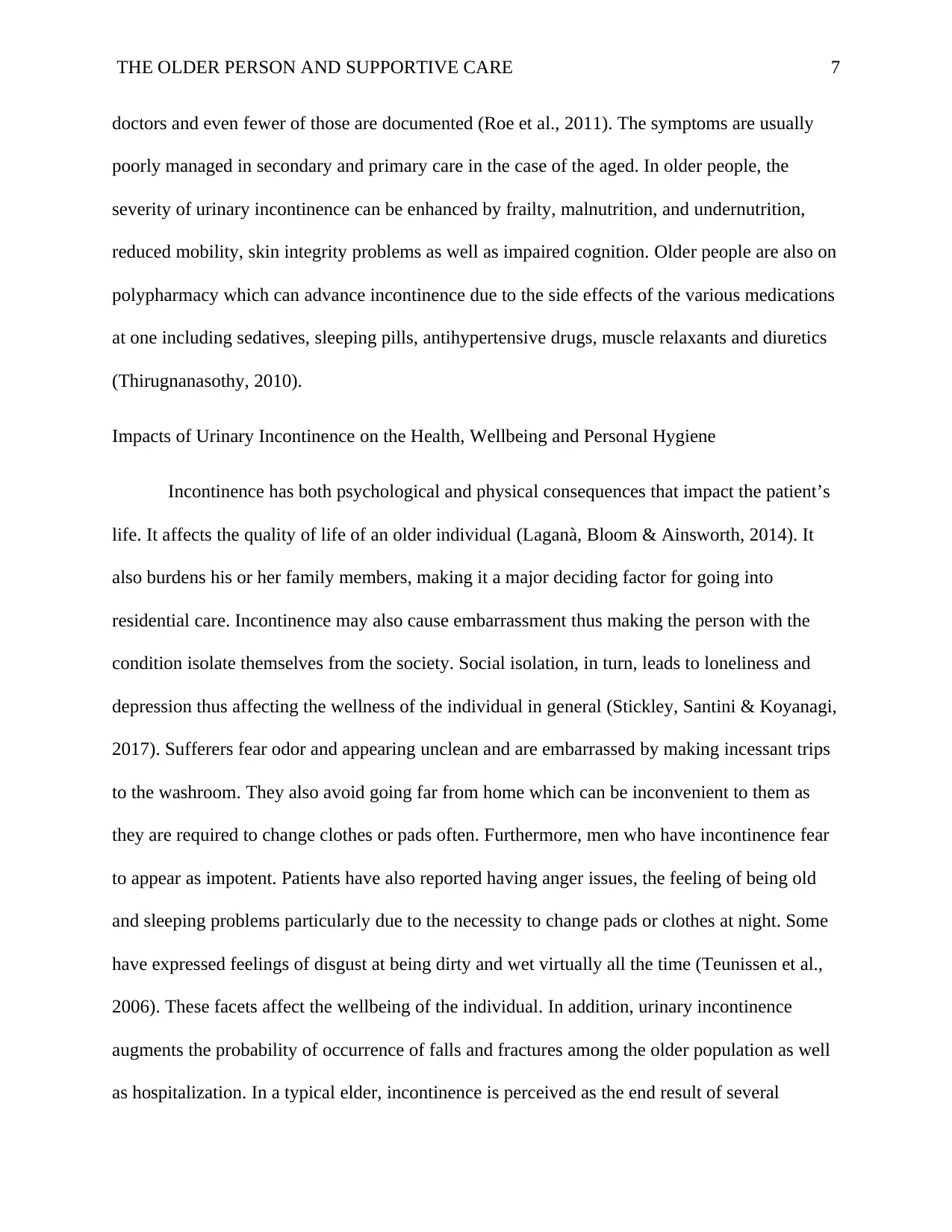
THE OLDER PERSON AND SUPPORTIVE CARE 7
doctors and even fewer of those are documented (Roe et al., 2011). The symptoms are usually
poorly managed in secondary and primary care in the case of the aged. In older people, the
severity of urinary incontinence can be enhanced by frailty, malnutrition, and undernutrition,
reduced mobility, skin integrity problems as well as impaired cognition. Older people are also on
polypharmacy which can advance incontinence due to the side effects of the various medications
at one including sedatives, sleeping pills, antihypertensive drugs, muscle relaxants and diuretics
(Thirugnanasothy, 2010).
Impacts of Urinary Incontinence on the Health, Wellbeing and Personal Hygiene
Incontinence has both psychological and physical consequences that impact the patient’s
life. It affects the quality of life of an older individual (Laganà, Bloom & Ainsworth, 2014). It
also burdens his or her family members, making it a major deciding factor for going into
residential care. Incontinence may also cause embarrassment thus making the person with the
condition isolate themselves from the society. Social isolation, in turn, leads to loneliness and
depression thus affecting the wellness of the individual in general (Stickley, Santini & Koyanagi,
2017). Sufferers fear odor and appearing unclean and are embarrassed by making incessant trips
to the washroom. They also avoid going far from home which can be inconvenient to them as
they are required to change clothes or pads often. Furthermore, men who have incontinence fear
to appear as impotent. Patients have also reported having anger issues, the feeling of being old
and sleeping problems particularly due to the necessity to change pads or clothes at night. Some
have expressed feelings of disgust at being dirty and wet virtually all the time (Teunissen et al.,
2006). These facets affect the wellbeing of the individual. In addition, urinary incontinence
augments the probability of occurrence of falls and fractures among the older population as well
as hospitalization. In a typical elder, incontinence is perceived as the end result of several
doctors and even fewer of those are documented (Roe et al., 2011). The symptoms are usually
poorly managed in secondary and primary care in the case of the aged. In older people, the
severity of urinary incontinence can be enhanced by frailty, malnutrition, and undernutrition,
reduced mobility, skin integrity problems as well as impaired cognition. Older people are also on
polypharmacy which can advance incontinence due to the side effects of the various medications
at one including sedatives, sleeping pills, antihypertensive drugs, muscle relaxants and diuretics
(Thirugnanasothy, 2010).
Impacts of Urinary Incontinence on the Health, Wellbeing and Personal Hygiene
Incontinence has both psychological and physical consequences that impact the patient’s
life. It affects the quality of life of an older individual (Laganà, Bloom & Ainsworth, 2014). It
also burdens his or her family members, making it a major deciding factor for going into
residential care. Incontinence may also cause embarrassment thus making the person with the
condition isolate themselves from the society. Social isolation, in turn, leads to loneliness and
depression thus affecting the wellness of the individual in general (Stickley, Santini & Koyanagi,
2017). Sufferers fear odor and appearing unclean and are embarrassed by making incessant trips
to the washroom. They also avoid going far from home which can be inconvenient to them as
they are required to change clothes or pads often. Furthermore, men who have incontinence fear
to appear as impotent. Patients have also reported having anger issues, the feeling of being old
and sleeping problems particularly due to the necessity to change pads or clothes at night. Some
have expressed feelings of disgust at being dirty and wet virtually all the time (Teunissen et al.,
2006). These facets affect the wellbeing of the individual. In addition, urinary incontinence
augments the probability of occurrence of falls and fractures among the older population as well
as hospitalization. In a typical elder, incontinence is perceived as the end result of several
Paraphrase This Document
Need a fresh take? Get an instant paraphrase of this document with our AI Paraphraser
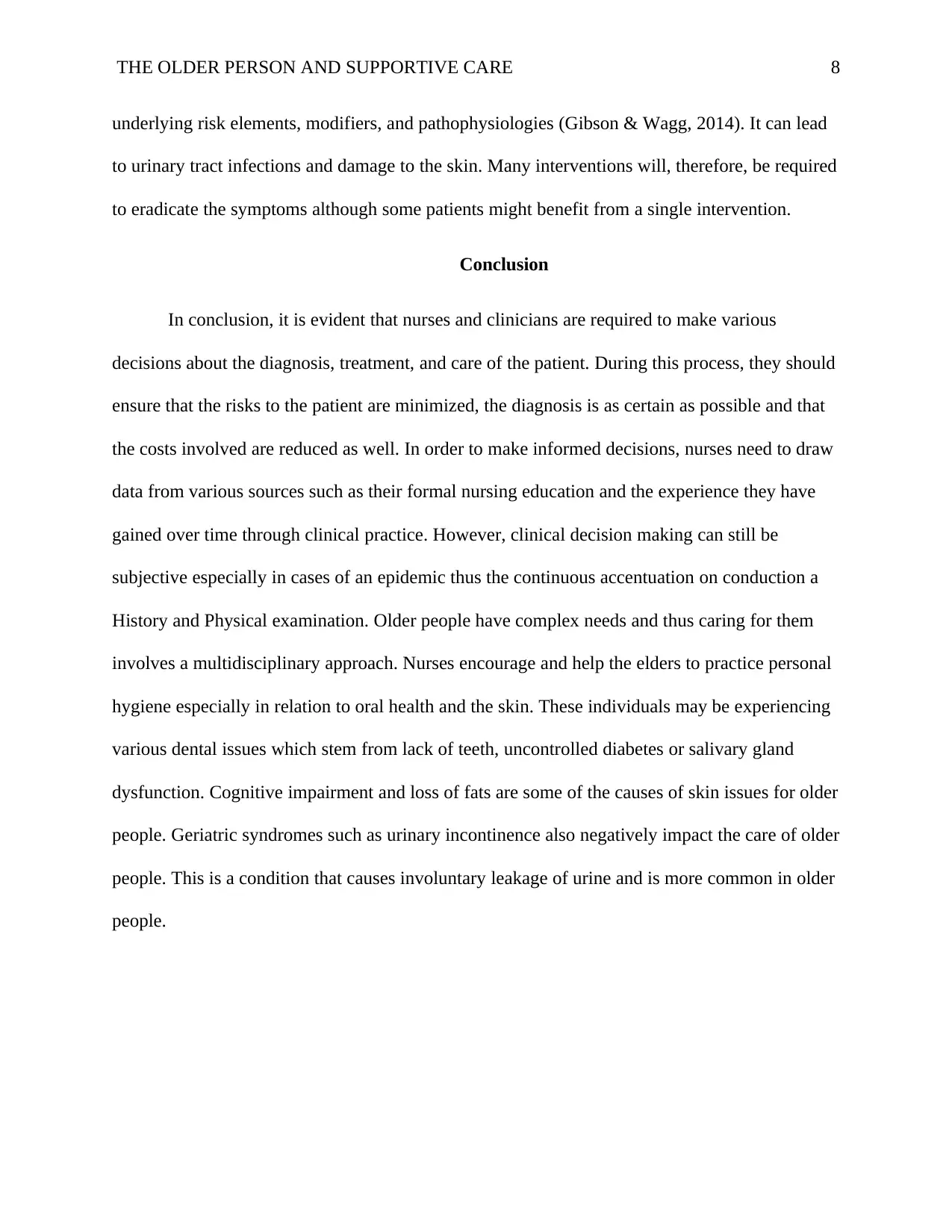
THE OLDER PERSON AND SUPPORTIVE CARE 8
underlying risk elements, modifiers, and pathophysiologies (Gibson & Wagg, 2014). It can lead
to urinary tract infections and damage to the skin. Many interventions will, therefore, be required
to eradicate the symptoms although some patients might benefit from a single intervention.
Conclusion
In conclusion, it is evident that nurses and clinicians are required to make various
decisions about the diagnosis, treatment, and care of the patient. During this process, they should
ensure that the risks to the patient are minimized, the diagnosis is as certain as possible and that
the costs involved are reduced as well. In order to make informed decisions, nurses need to draw
data from various sources such as their formal nursing education and the experience they have
gained over time through clinical practice. However, clinical decision making can still be
subjective especially in cases of an epidemic thus the continuous accentuation on conduction a
History and Physical examination. Older people have complex needs and thus caring for them
involves a multidisciplinary approach. Nurses encourage and help the elders to practice personal
hygiene especially in relation to oral health and the skin. These individuals may be experiencing
various dental issues which stem from lack of teeth, uncontrolled diabetes or salivary gland
dysfunction. Cognitive impairment and loss of fats are some of the causes of skin issues for older
people. Geriatric syndromes such as urinary incontinence also negatively impact the care of older
people. This is a condition that causes involuntary leakage of urine and is more common in older
people.
underlying risk elements, modifiers, and pathophysiologies (Gibson & Wagg, 2014). It can lead
to urinary tract infections and damage to the skin. Many interventions will, therefore, be required
to eradicate the symptoms although some patients might benefit from a single intervention.
Conclusion
In conclusion, it is evident that nurses and clinicians are required to make various
decisions about the diagnosis, treatment, and care of the patient. During this process, they should
ensure that the risks to the patient are minimized, the diagnosis is as certain as possible and that
the costs involved are reduced as well. In order to make informed decisions, nurses need to draw
data from various sources such as their formal nursing education and the experience they have
gained over time through clinical practice. However, clinical decision making can still be
subjective especially in cases of an epidemic thus the continuous accentuation on conduction a
History and Physical examination. Older people have complex needs and thus caring for them
involves a multidisciplinary approach. Nurses encourage and help the elders to practice personal
hygiene especially in relation to oral health and the skin. These individuals may be experiencing
various dental issues which stem from lack of teeth, uncontrolled diabetes or salivary gland
dysfunction. Cognitive impairment and loss of fats are some of the causes of skin issues for older
people. Geriatric syndromes such as urinary incontinence also negatively impact the care of older
people. This is a condition that causes involuntary leakage of urine and is more common in older
people.
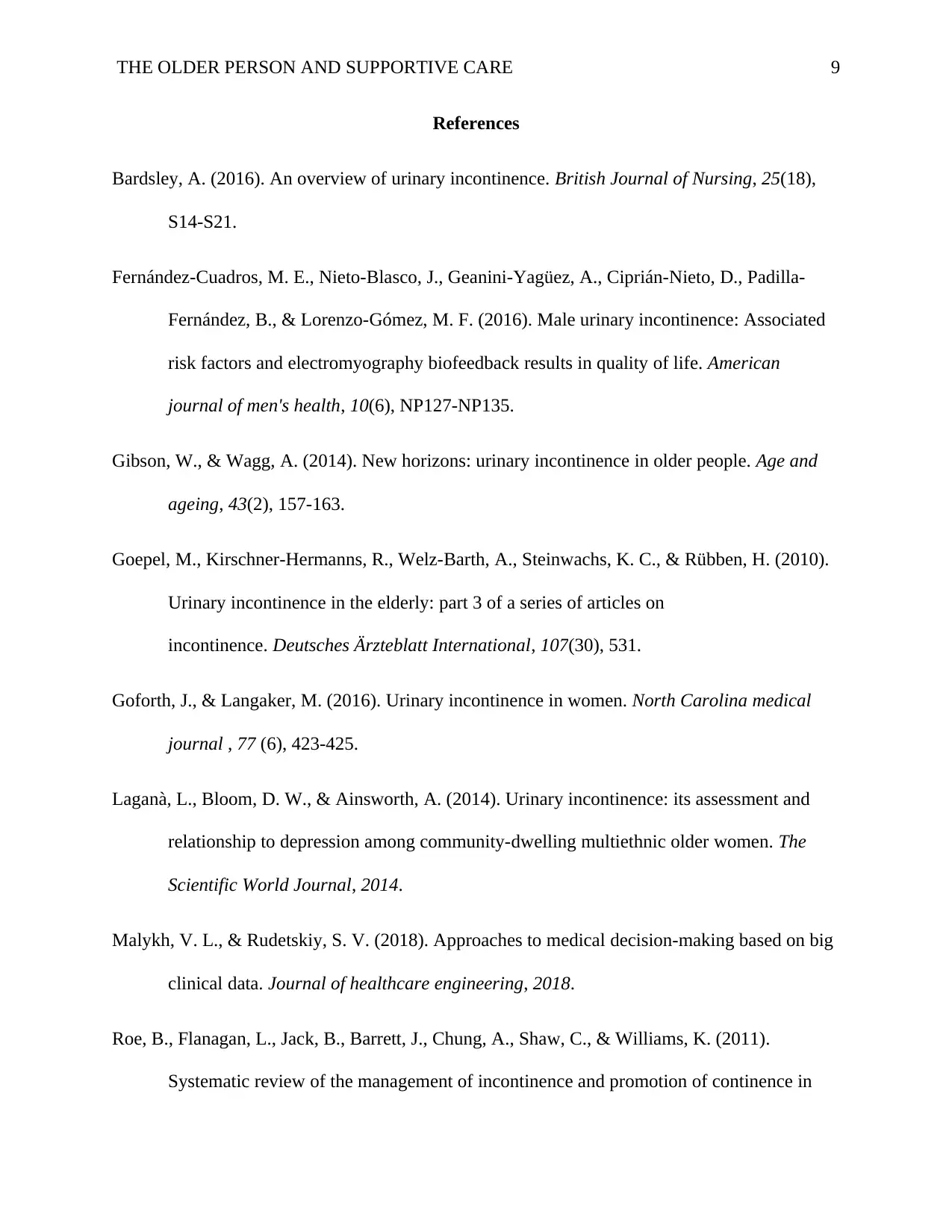
THE OLDER PERSON AND SUPPORTIVE CARE 9
References
Bardsley, A. (2016). An overview of urinary incontinence. British Journal of Nursing, 25(18),
S14-S21.
Fernández-Cuadros, M. E., Nieto-Blasco, J., Geanini-Yagüez, A., Ciprián-Nieto, D., Padilla-
Fernández, B., & Lorenzo-Gómez, M. F. (2016). Male urinary incontinence: Associated
risk factors and electromyography biofeedback results in quality of life. American
journal of men's health, 10(6), NP127-NP135.
Gibson, W., & Wagg, A. (2014). New horizons: urinary incontinence in older people. Age and
ageing, 43(2), 157-163.
Goepel, M., Kirschner-Hermanns, R., Welz-Barth, A., Steinwachs, K. C., & Rübben, H. (2010).
Urinary incontinence in the elderly: part 3 of a series of articles on
incontinence. Deutsches Ärzteblatt International, 107(30), 531.
Goforth, J., & Langaker, M. (2016). Urinary incontinence in women. North Carolina medical
journal , 77 (6), 423-425.
Laganà, L., Bloom, D. W., & Ainsworth, A. (2014). Urinary incontinence: its assessment and
relationship to depression among community-dwelling multiethnic older women. The
Scientific World Journal, 2014.
Malykh, V. L., & Rudetskiy, S. V. (2018). Approaches to medical decision-making based on big
clinical data. Journal of healthcare engineering, 2018.
Roe, B., Flanagan, L., Jack, B., Barrett, J., Chung, A., Shaw, C., & Williams, K. (2011).
Systematic review of the management of incontinence and promotion of continence in
References
Bardsley, A. (2016). An overview of urinary incontinence. British Journal of Nursing, 25(18),
S14-S21.
Fernández-Cuadros, M. E., Nieto-Blasco, J., Geanini-Yagüez, A., Ciprián-Nieto, D., Padilla-
Fernández, B., & Lorenzo-Gómez, M. F. (2016). Male urinary incontinence: Associated
risk factors and electromyography biofeedback results in quality of life. American
journal of men's health, 10(6), NP127-NP135.
Gibson, W., & Wagg, A. (2014). New horizons: urinary incontinence in older people. Age and
ageing, 43(2), 157-163.
Goepel, M., Kirschner-Hermanns, R., Welz-Barth, A., Steinwachs, K. C., & Rübben, H. (2010).
Urinary incontinence in the elderly: part 3 of a series of articles on
incontinence. Deutsches Ärzteblatt International, 107(30), 531.
Goforth, J., & Langaker, M. (2016). Urinary incontinence in women. North Carolina medical
journal , 77 (6), 423-425.
Laganà, L., Bloom, D. W., & Ainsworth, A. (2014). Urinary incontinence: its assessment and
relationship to depression among community-dwelling multiethnic older women. The
Scientific World Journal, 2014.
Malykh, V. L., & Rudetskiy, S. V. (2018). Approaches to medical decision-making based on big
clinical data. Journal of healthcare engineering, 2018.
Roe, B., Flanagan, L., Jack, B., Barrett, J., Chung, A., Shaw, C., & Williams, K. (2011).
Systematic review of the management of incontinence and promotion of continence in
⊘ This is a preview!⊘
Do you want full access?
Subscribe today to unlock all pages.

Trusted by 1+ million students worldwide
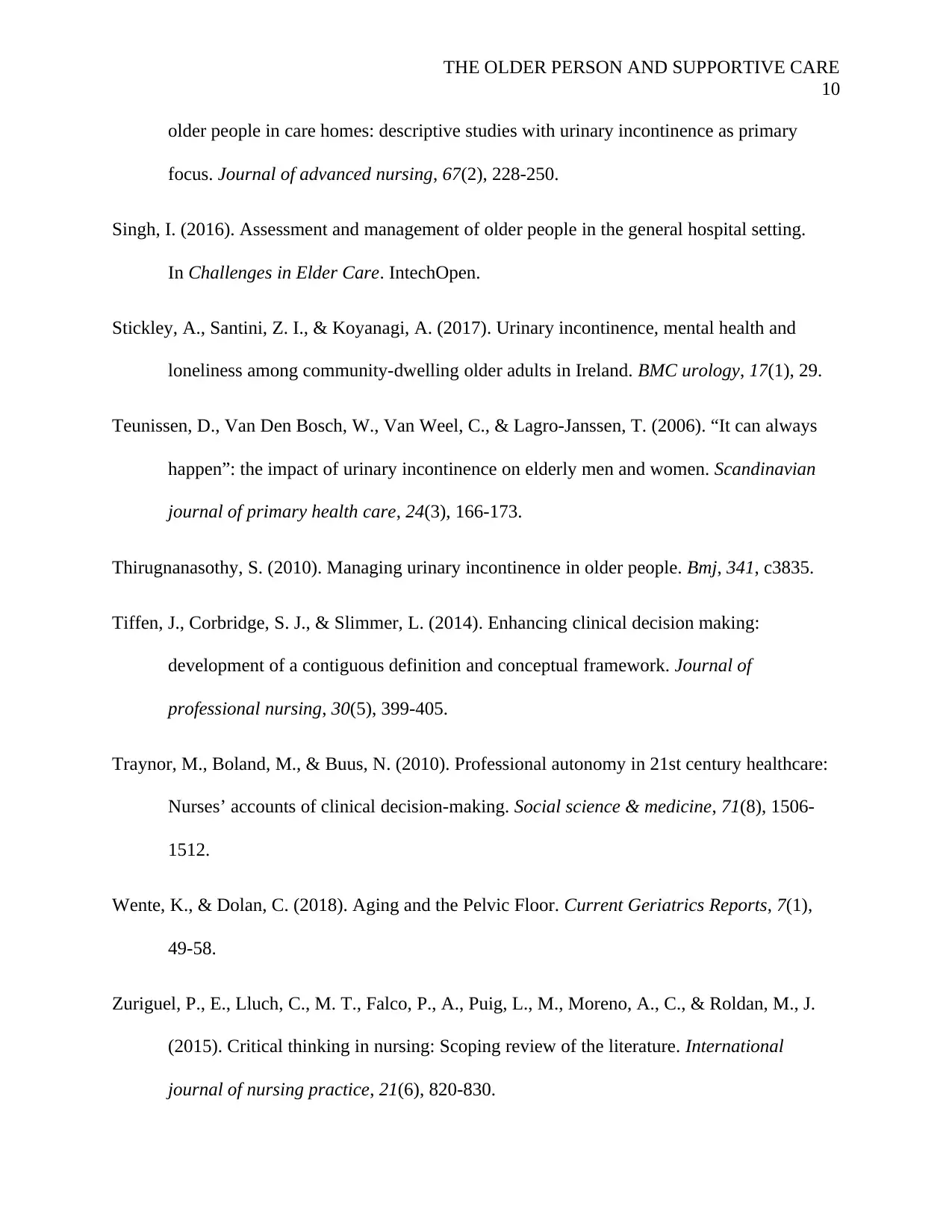
THE OLDER PERSON AND SUPPORTIVE CARE
10
older people in care homes: descriptive studies with urinary incontinence as primary
focus. Journal of advanced nursing, 67(2), 228-250.
Singh, I. (2016). Assessment and management of older people in the general hospital setting.
In Challenges in Elder Care. IntechOpen.
Stickley, A., Santini, Z. I., & Koyanagi, A. (2017). Urinary incontinence, mental health and
loneliness among community-dwelling older adults in Ireland. BMC urology, 17(1), 29.
Teunissen, D., Van Den Bosch, W., Van Weel, C., & Lagro-Janssen, T. (2006). “It can always
happen”: the impact of urinary incontinence on elderly men and women. Scandinavian
journal of primary health care, 24(3), 166-173.
Thirugnanasothy, S. (2010). Managing urinary incontinence in older people. Bmj, 341, c3835.
Tiffen, J., Corbridge, S. J., & Slimmer, L. (2014). Enhancing clinical decision making:
development of a contiguous definition and conceptual framework. Journal of
professional nursing, 30(5), 399-405.
Traynor, M., Boland, M., & Buus, N. (2010). Professional autonomy in 21st century healthcare:
Nurses’ accounts of clinical decision-making. Social science & medicine, 71(8), 1506-
1512.
Wente, K., & Dolan, C. (2018). Aging and the Pelvic Floor. Current Geriatrics Reports, 7(1),
49-58.
Zuriguel, P., E., Lluch, C., M. T., Falco, P., A., Puig, L., M., Moreno, A., C., & Roldan, M., J.
(2015). Critical thinking in nursing: Scoping review of the literature. International
journal of nursing practice, 21(6), 820-830.
10
older people in care homes: descriptive studies with urinary incontinence as primary
focus. Journal of advanced nursing, 67(2), 228-250.
Singh, I. (2016). Assessment and management of older people in the general hospital setting.
In Challenges in Elder Care. IntechOpen.
Stickley, A., Santini, Z. I., & Koyanagi, A. (2017). Urinary incontinence, mental health and
loneliness among community-dwelling older adults in Ireland. BMC urology, 17(1), 29.
Teunissen, D., Van Den Bosch, W., Van Weel, C., & Lagro-Janssen, T. (2006). “It can always
happen”: the impact of urinary incontinence on elderly men and women. Scandinavian
journal of primary health care, 24(3), 166-173.
Thirugnanasothy, S. (2010). Managing urinary incontinence in older people. Bmj, 341, c3835.
Tiffen, J., Corbridge, S. J., & Slimmer, L. (2014). Enhancing clinical decision making:
development of a contiguous definition and conceptual framework. Journal of
professional nursing, 30(5), 399-405.
Traynor, M., Boland, M., & Buus, N. (2010). Professional autonomy in 21st century healthcare:
Nurses’ accounts of clinical decision-making. Social science & medicine, 71(8), 1506-
1512.
Wente, K., & Dolan, C. (2018). Aging and the Pelvic Floor. Current Geriatrics Reports, 7(1),
49-58.
Zuriguel, P., E., Lluch, C., M. T., Falco, P., A., Puig, L., M., Moreno, A., C., & Roldan, M., J.
(2015). Critical thinking in nursing: Scoping review of the literature. International
journal of nursing practice, 21(6), 820-830.
1 out of 10
Related Documents
Your All-in-One AI-Powered Toolkit for Academic Success.
+13062052269
info@desklib.com
Available 24*7 on WhatsApp / Email
![[object Object]](/_next/static/media/star-bottom.7253800d.svg)
Unlock your academic potential
Copyright © 2020–2025 A2Z Services. All Rights Reserved. Developed and managed by ZUCOL.




